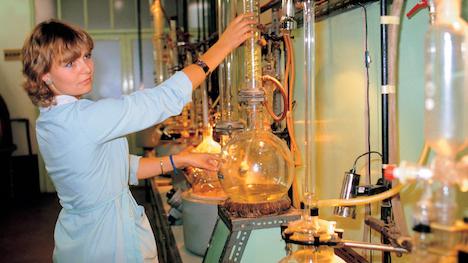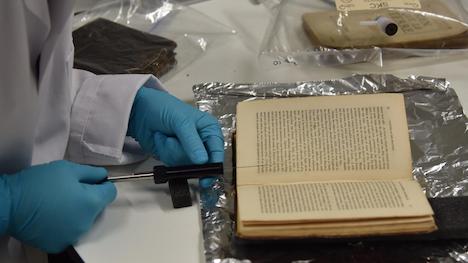| This might seem to be the most mind-bogglingly waste of scientific expertise and expense. Yet the article caught my attention because I get it. One of the most treasured memories of my life is the smell of old books and old libraries. Yes, I know that sounds weird but so many of the days of my youth - beginning at about age 8 - were spent in the local library. It was a place of refuge from a less than satisfactory childhood, and I found the smell of the place very powerful. I can still smell it today, more than 60 years later. Old books - whether in libraries or used book stores - have the same captivating enticement for me. It's not quite an erotic scent, but it isn't far from it either. I get a rush of endorphins when I recall those smells and I'm positively overwhelmed if I'm actually in the presence of the smells, not just the memory of them. Even though most of what I read these days is online, I still get immense pleasure from burying my nose deep into an old book. I keep many of them around just to enjoy that simple memory from the days of my youth. - prh, ed. The smells of ordinary life, from traditional pubs to old books, are part of our culture and heritage – and many of them are in danger of being lost. Imagine an old leather-bound book just pulled out from a wooden shelf. Its yellowed pages release dust as they open. Even before you begin to read the book, the unique smell of it fills your nose. This familiar scent is not only a simple pleasure for people who like to peruse libraries and bookshops. These smells have a cultural heritage value, and they are at risk of being lost. For every old book that falls apart, is thrown away or kept locked behind a temperature-controlled curatorial door, these scents become harder to experience. It is a problem that is far from unique to books – from perfumeries and pubs to entire cities, the background scents of our lives are changing all the time. For Cecilia Bembibre, a researcher at the UCL Institute for Sustainable Heritage, the smell of old books is important. She is developing different techniques to recover “extinct” scents from the past and to preserve those around today for the future. It’s a facet of heritage that is often, quite literally, overlooked. “The proposals made by cultural heritage spaces such as galleries, museums, historic houses, are mostly focused on the sight,” says Bembibre. “The engagement they propose tends to be visual. [With] some exceptions, the stimulation of senses, like the objects that can be touched or smelled, is reserved for children.” Bembibre is trying to rectify that neglect of scent. “I wanted to address an issue that has been researched quite little – that has to do with smells as the olfactory heritage of humanity.” But how do you capture something as intangible as a historical scent? One method involves exposing a polymer fibre to the odour, so that the smell-causing chemical compounds in the air can stick to it. Then Bembibre analyses the sample in the laboratory, dissolving the compounds stuck to the fibre, separating them and identifying them. The resulting list of chemicals is effectively a recipe for the scent.
Another method separates and identifies the compounds directly from the gas sample – an approach commonly used in the perfume, food and beverages industry, as it allows volatile odour-active compounds to be identified. A third way is to use the nose itself, either by asking panels of people to describe certain smells, or by asking expert “noses”, who may be perfumers or scent designers. “We characterise the smell from the human point of view,” adds Bembibre. “This is important because if we want to preserve it for the future, it depends on many factors. Not only the chemical composition but also our experience.” Bembibre has chemically extracted the smells of old leather gloves, ancient books and mould, among other things. She has reinterpreted the smells of a 1750 potpourri house recipe and of the old books housed in St Paul’s cathedral. To do this, she reinterprets them from the smell’s chemical compounds until reaching the same scent.
In 2003, Unesco adopted a convention to safeguard intangible cultural heritage, which includes social practices, oral traditions and performing arts. Where, though, were the scents? For centuries there have been cultural practices where smell plays a vital role, like the Spanish Fiesta of the patios in Cordova or the Holy Week processions in Popayán, Colombia. In 2018, the skills related to perfumery in Pays de Grasse, France, were included on the intangible heritage list. No scents themselves, however, are listed. Other countries have also made efforts to recognise the value of their odours. In 2001, Japan’s environment minister classified the country’s top 100 best-smelling spots, which included both natural and cultural sites. Later, in 2016, the Koç University’s Research Center for Anatolian Civilizations in Istanbul opened the exhibition “Scents and the City” to explore 4,000 years of civilisation through its smells. “There is a way of inscribing these things into world heritage lists, in the same way as a world heritage site managed by Unesco. So it is part of a whole intangible heritage world,” says Katy Lithgow, an independent specialist in cultural heritage conservation and former head of conservators for the UK’s National Trust. But, as with French perfumery culture, it is rare for a scent to be the focus of conservation in its own right. In some cases, a conservator might only be concerned with a scent when it is a warning sign that something is deteriorating – the smell of rotting organic matter or decay.
Despite the overall neglect of odours as heritage, some olfactory enthusiasts are working to preserve meaningful everyday scents before they disappear. Kate McLean, the creator of Sensory Maps, is a researcher and visual artist who works “at the intersection of human-perceived smellscapes, cartography and the communication of ‘eye-invisible’ sensed data”. Her goal is to create “smellmaps”. These maps aren’t limited to geographically distributed smells. They can also include changes over time, comparing the morning and afternoon odours of the streets in Shanghai, or focus solely on the summer smells of Le Marais, Paris. McLean also considers smells of the past, creating a smellmap of the famously pungent Widnes, Lancashire, an old manufacturing town. In the 19th and early 20th Centuries, Widnes was home to soap factories and a thriving chemical manufacturing industry. Today, those factories are gone and the contemporary smellscape is quite different. McLean wanted to explore Widnes’ “smelly history” as well as its contemporary smellscape. McLean creates maps of towns like Widnes overlaid with data on what scents can be perceived in a specific area. She also uses “smellwalks”, graphic design and smell generation and diffusion to explore the complexity of aromatic landscapes and the way we relate to them.
But why does a town’s smell matter? What valuable information is written into the odour of a city, street or building? It runs a lot deeper than just preserving a scent for its novelty, says Alex Rhys-Taylor of Goldsmiths University, who specialises in the multisensory experience of urban space. “I would say, through my research, that you can learn a lot about a city’s economy, a lot about its culture, through the sense of smell.” Take London, for example. A deep breath of not-so-fresh air in a typical Central London street might bring you a waft of an Indian curry restaurant, an English pub and traffic exhaust fumes. “The smells and taste in London give you a strong sense of place, a sense of locality, and part of that is that contemporary cities reveal particular paths of migration,” says Rhys-Taylor. “It generally has global roots [and] that has to do with the city’s colonial history.” But these particular smells, while omnipresent to those living in the city, will not be around forever. “What we increasingly see is the arrival of a transnational aromascape or flavourscape,” says Rhys-Taylor. “It is pretty much the same in every global city now: smell of pulled pork, flat whites, roasting coffee beans is an increasing one, microbreweries. There is a global constellation of transnational aromas and flavours associated with a transnational class, people that move around from city to city.” This evolution of smells is the motivation for the work of UCL’s Cecilia Bembibre. Cities continuously lose their characteristic odours. Yet, even as scents are disappearing, developing new ones is becoming crucial to their conservation.
Back in Bembibre’s lab, she took two routes to recreate the smell of an old library. One was a literal chemical recreation of volatile molecules found in that environment. The other one was an intuitive interpretation by perfumer Sarah McCartney. Then Bembibre asked different people which smell resembled an old library the most. “The truth is that the results surprised me, because it was almost 50:50,” she says. “If anything, more people chose the interpreted smell rather than the extracted one.” What Bembibre took from that was that it might not be necessary to use a mimic at the chemical level to recreate the scent of an old library. “Sometimes the reproduction [by] an artist can evoke an experience with the same power.” It remains an open question whether an artist’s interpretation has more or less authenticity than a chemical mimic. These are questions Bembibre aims to parse out when she creates a “smells archive” to record heritage scents that would otherwise be lost. Such an archive would raise another important curatorial question: which smells should be preserved? The National Trust’s former head of conservators, Katy Lithgow, suggests that the same criteria used for heritage sites could apply to scents. “It has to do with how these smells are associated with people, really. So the first thing is to consult with people about what sort of smells they think are valuable,” says Lithgow. These values can be traditional ones, like historic or aesthetic value. Or they could be economic, scientific, utilitarian, cultural, communal, emotional values. Determining which values are important can involve consultation with both experts and communities, says Lithgow. “I am not sure that anybody has embarked yet on a kind of review of what the world’s most significant smells are and whether they are at risk.”
While it might take some time to create a smells archive, Rhys-Tylor suggests that the eventual process should keep in mind a social class diversity, and avoid preserving only the scents of privileged spaces. “With any creation of an archive there is a big question of what is being selected,” he says. “It would concern me if we were only curating or collecting the aromas of a specific social sector.” Rhys-Tylor describes the smell of a pub “full of smoke and men and beer spilled on the floor and disinfectant coming out of the toilets”, as an example. “That is a very important collection in terms of the social history of the city,” he says, talking about a characteristic London scent. “Those types of spaces and atmospheres are perhaps more important to the city than tearooms or perfume isles.” These questions – the choice of which smells truly represent a place or culture, and which are authentic – will continue to shape the archive that Bembibre dreams of. Until then, she plans to continue her search for the culturally important odours that are still around today, and to revive those that have been lost. Source URL |





